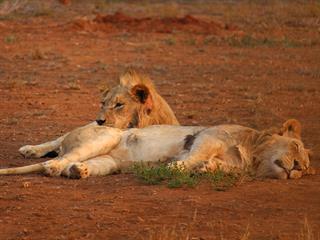
Genetically distinct from the pride of 13 lions already in uMkhuze, the males from Tswalu, South Africa’s largest private game reserve at over 110 000ha, will introduce a fresh bloodline into iSimangaliso’s lions.
According to the iSimangaliso Wetland Park Authority, the last lion in the area was shot and killed after it escaped 47 years ago. However, as part of its efforts to re-wild iSimangaliso, park authorities began gradually reintroducing lions into uMkhuze in December 2013.
“The first family of four lions – translocated from Tembe Elephant Park [in KZN] – were released in December 2013 and comprised an adult female and three sub-adult offspring. This was followed by two male [siblings] and three females during 2014,” a statement by iSimangaliso said.
Two sets of lion cubs have been born in uMkhuze since then, and the three males from Tswalu Kalahari Reserve has now brought iSimangaliso’s lion numbers to 16.
“In addition to the ecological benefits, the introduction of lion has boosted tourism to the uMkhuze section of iSimangaliso. The pride of lion are regularly seen, along with the two packs of painted dogs (African wild dogs),” said iSimangaliso’s CEO, Andrew Zaloumis.
All adult lions have been fitted with satellite-based tracking collars to monitor their movements for biological and safety purposes.
“iSimangaliso can now proclaim itself as the most diverse park in Africa. All key terrestrial animals have been introduced including lion, cheetah, wild dog, rhino, tsessebe, and oribi. Marine life includes protected whale and shark populations, coelacanths, turtles, as well as a myriad of species on our coral reefs,” said Zaloumis.











